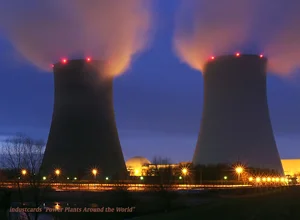
Climate change is an evergreen problem (pun mostly intended). The world's leading scientists say we must decarbonize the world's economy by mid-century to avert a global climate catastrophe. Could nuclear power—a traditionally controversial and costly method of power generation—be once again considered an integral and ongoing part of the solution?
New renewable energy resources have come to the fore since the early 80s, when climate change wasn’t a hot button issue. At that time, a reactor went online every 17 days. Now, twenty-five years later, only one nuclear power plant has been licensed in the United States. The cost of building one has doubled, as well, and with high financial risk comes increased hesitancy among investors.
For the most part, it’s far more economical to invest in solar, wind, and hydroelectric, but the transition to such methods could take quite a bit of time. Therefore, some believe that the most cost-efficient method of decarbonizing is nuclear energy. Waiting for the sun to shine or the wind to blow, coupled with the high cost of large scale battery storage, can itself be a high risk proposition – in particular if you remove the option of nuclear energy completely from the equation.
Recently, MIT's Center for Advanced Nuclear Energy Systems has been working on advanced nuclear plant designs and construction techniques. Waste is still a major concern, but by thinking small, with simple, faster and cheaper nuclear reactor designs, radioactive waste cleanup and treatment becomes more manageable – as does recouping costs for reactors that only cost $10 billion as opposed to more than twice that figure.
A smaller nuclear reactor design that eliminates the need for reactor coolant pumps also eliminates two-thirds of the systems and components you find in a large plant and takes up just 1% of the space of a conventional reactor. And as these reactors are buried deep in the earth and surrounded by millions of gallons of water, a single reactor could power an entire region with a dozen serving a whole city. Fewer parts means less cost and a less likelihood that something can break or go wrong. At that point, it become safer and more cost-effective to build, especially if a standardized design is established and mass produced for transport and ground installation.
Other design ideas are already in production outside of the U.S., with Russia and China producing “floating” power plants that can move to where they’re most needed. The reactors are built and floated out to areas that require electricity. If a more profitable site becomes identified, the portable plant is simply moved there.
So will history finally be catching back up to power generation? Perhaps, but not yet in the short term. In fact, the famous Three Mile Island nuclear plant officially shut down this past Friday due to a lack of state action in subsidizing clean energy. However, it will take decades for the plant to be completely cleaned up at a cost of around $1.2 billion. It’s estimated that all radioactive material will be removed by 2078.
Regardless of a reactor’s design, waste and cleanup remains a major concern. Graver offers filtration, deionization, and radionuclide reduction products such as Ecodex, Gravex and Powdex to treat wastewater and remove reactor contaminants.
Need help?
You can find the right application or product using our Tool, or through our Chat Bot.
Keep In Touch
Keep up to date with our latest news and announcements. Unsubscribe anytime.




.svg)
.svg)



